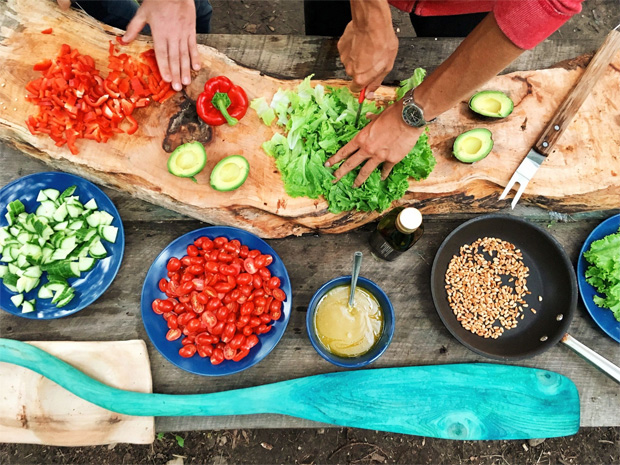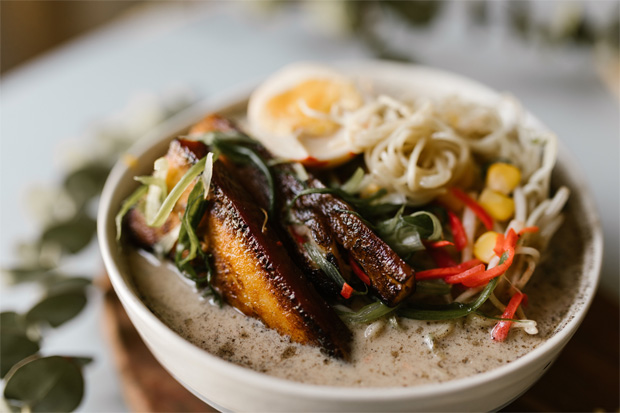You Can’t Experience a Country Without Experiencing Its Food

You Can’t Experience a Country Without Experiencing Its Food
Guest article by Mark Bibby Jackson from TravelBeginsAt40.com
My most memorable meal in Vietnam was one shared with work colleagues at a restaurant in Hanoi. The meal was a fish. One fish. Between the dozen or so of us, served over numerous courses, leaving nothing to waste – even the innards. This fish was not a small fish.
Unlike the way that Vietnamese is often served in the West, dishes do not arrive haphazardly at roughly the same time, but in Hanoi they are carefully choreographed. The tastiest dishes arrive first while your palette is at its most refined. The rice comes towards the end of the meal sometime around the vegetable course and broth to ensure that nobody leaves hungry. The meal always concludes with a fruit dish.
I believe I understood more about my colleagues in that one meal than I did from weeks of working with them. I also realised how much we have in common. After all some of my strongest childhood memories are of going to my Nana’s house to have our Christmas lunch. The food might have been different – I don’t think my grandmother could have fed the whole family on a solitary cod – but the importance of food, and the ceremony of the turkey being presented to all assembled prior to carving was an essential part of our family life.

Part of the culture of food lies not just in what you eat, bit in how it is presented. In Japan, so much of the food culture revolves around the ceremony. This helps to swiftly remove any lingering discomfort you feel from sitting cross-legged before some miniaturised table that would better serve as a footrest.
Eating like the locals does involve an element of risk. I soon realised the best way to avoid nasty surprises in Vietnam was to explain that I did not eat the insides of animals, not that this always helped me as I discovered when I tucked into a piece of pasta that turned out to be part of some animal’s stomach.
However, to really understand a culture and to get to know the people better you should be prepared to leave your culinary comfort zone. Whether it is eating fried spiders in Cambodia, snake blood in Vietnam or guinea pigs in Peru, you will begin to understand more about what makes your host community tick if you join in too.

Wherever I am I always ask to eat and drink whatever is local. Putting aside the environmental benefits of ordering locally sourced food, sampling what your host community eats provides you with an insight into their culture, environment and history.
Cambodians eat a lot of prahok or fermented fish. The pungent dish is not to everyone’s taste, but it makes you realise how the local people used to preserve food through the dry season when the waters of the Tonle Sap Lake in the middle of the country receded and there were fewer fish to preserve. The Faroe Islands also traditionally fermented food to preserve it, as well as smoking fish, as we have in the UK. You see there are so many similarities despite the apparent differences.
Nepal is one of my favourite countries to visit. As soon as I touch ground, I want to try some dal bhat. A simple thali dish consisting of rice, dal, vegetable curry, poppadum and pickle. It is cheap, voluminous and really nutritious. Waiters will willingly top you up all day if you like. I would eat it happily for lunch and dinner every day and did so often while trekking. In Kathmandu they sell t-shirts announcing that dal bhat will give you power for 24 hours, which is good to keep in mind if attempting the Everest Base Camp.
Many tourists opt to go on cookery courses or cookery tours. Personally, I am rather sceptical of these, having gone on a few disappointing ones in the past. Essentially, they are designed for tourists and as such they can easily fall into the trap of providing travellers with what the host thinks they want, not what the locals actually eat. However, I did once have a great time in El Salvador trying to prepare some pupasas, the natural dish made of flatbreads stuffed with a combination of cheese, pork and refried beans. My effort tasted great, despite not quite looking like my instructor’s prototype.

On one of my recent trips to Thailand, a country I have visited for three decades including establishing a lifestyle magazine in Bangkok, I found myself in a tourist resort town surrounded by fellow travellers. Hard as I tried, I couldn’t find a local place to sit and try the local fish washed down with a bottle of Leo beer with ice. Eventually I chose one touristy restaurant, and sat next to a table of European tourists who asked for their food to be without heat. Now asking for Thai food, which is based upon the principle of balancing spice with sugar to be “without heat” is a bit like ordering fish without chips. You might like it, but it is not authentic. Hard as I tried to explain that I wanted Thai food like Thai people, my blond hair, blue eyes and paltry Thai betrayed me, so I settled down to an average meal, surrounded by a cacophony of approving ‘delicious’ from my neighbours.
You can hardly blame the locals for providing the food that they assume travellers prefer. However, it can result in people getting completely the wrong impression of the food of a country and consequently their culture. Back in London, I have had chefs apologising for not serving proper Thai and Cambodian food, explaining that if they had prepared it authentically nobody would eat it.
As with all travel there is no quick fix. If you want to have a cursory understanding of a country’s culture and food, you can go on a tour or a cookery class and emerge with a stage-managed understanding. However, to really start to understand how the food of the country has emerged, you have to spend some time with the local people visiting the local markets with them, preparing food with them and then dining together.
And the slower you do it, the better the understanding you will get of the local community that is hosting you, and the more enriching your experience will be.
All the above has one massive caveat. There is an underlying assumption that food habits just like culture is permanent. Clearly it is not.
One of the greatest treats I have discovered while travelling around the UK and Europe in the last five years is how the food has evolved, and improved. Tasting menus represent a wonderful way of exploring a chef’s vision of food. When this is locally and ethically sourced it has the added benefit of being climate-friendly too.
One of my closest friends in Cambodia, the master chef Luu Meng, has reinterpreted traditional food to create a contemporary Cambodian cuisine, which reflects modern advances such as refrigerators and food mixers which were not around back in the time of Angkor. Similarly, my favourite Indian restaurant in London – the Grand Trunk Road – has sourced traditional Indian spices but applied them to food, such as lobster, that you would not associate with traditional Indian cuisine.
Nothing provides the traveller with a better insight into a country’s culture than its food. When I reflect upon the moments when I feel I have started to understand different cultures, invariably those moments revolve around food.
ABOUT THE AUTHOR
Mark Bibby Jackson is passionate about travel and sharing the joys of visiting new places and people. He is founder and group editor of websites Travel Begins at 40 and London Begins at 40, as well as the award-winning author of three thrillers set in Cambodia. He is the former editor of AsiaLIFE Cambodia, ASEAN Forum and Horizon Thailand magazines.
Guest Article.




